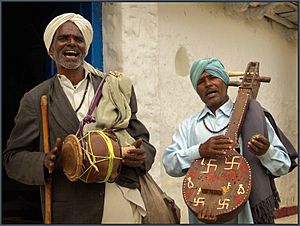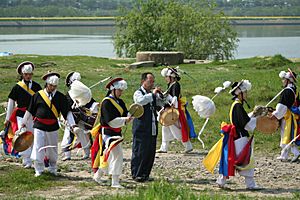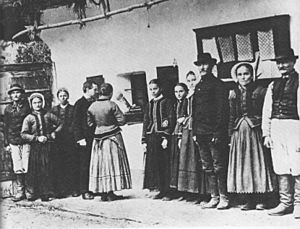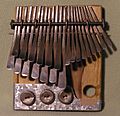Folk music facts for kids
Folk music is a special kind of music that people learn and share by listening to each other. It's often played by everyday people, not just professional musicians. This music is "handed down orally," which means it's taught by speaking and listening, not by reading sheet music. Think of it like a story or a game that your grandparents taught your parents, and then your parents taught you!
Every country and culture has its own unique traditional music. A folk song is a part of folk music, and a folksinger is someone who sings these songs.
In the 1960s, a new style of music called "folk rock" became popular. Musicians like Bob Dylan mixed traditional folk songs with rock and roll sounds.
Folk music is for everyone to enjoy, whether they are playing or listening. This makes it different from classical music, which is often created by professional musicians for a smaller audience. Folk music is a big part of a community's culture. However, today, "pop music" usually means music heard on television, radio, and through recordings.
In many parts of the world, most music is folk music. The term "folk music" often describes traditional European and American music. Today, folk music that is only passed down by listening is less common. This is partly because of new technology like radio, television, and music recordings. Now, folk tunes are often written down. They have also influenced other types of music, making the lines between different music styles less clear.
Contents
The Traditional Roots of Folk Music
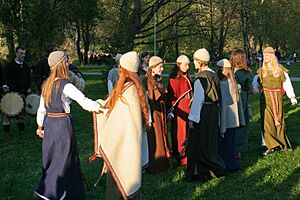
Long ago, folk music was a way for communities to relax and have fun together. People in villages or families would often play and sing music. They might even make up new songs or change old ones. This meant the music was always growing and changing. People would also share musical ideas with nearby groups. That's why folk music from neighboring countries often sounds similar.
Ballads and Storytelling
Ballads were a very popular type of folk music. These were folk songs that told a story. They often had a repeating part called a refrain after each verse, so everyone could sing along. Ballads told stories about love, myths, or local folklore. This was how important stories were passed down from one generation to another.
Instruments and Sounds
Instrumental folk music was often played for dancing. Some instruments were very simple, like sticks, rattles, or a basic drum. Other instruments might include a fiddle (which is a folk word for "violin"), bagpipes, a harp, a zither, or various wind instruments. The instruments used depended on the time period and the country.
Singing Styles
Some folk singing was polyphonic. This means two or more voices sang different parts at the same time. Often, two voices would sing in parallel, moving up and down together. In countries like Russia, people sang in three or four parts. This was part of a tradition called "podgolosnaya." In countries like Britain, this polyphonic style was not common. Folk songs there were usually sung by one person without any instruments.
Musical Scales
Folk music used different scales, which are also called modes. The Ionian mode, which sounds like our major scale, was common in Western Europe. In some parts of Eastern Europe, modes with several semitones (half steps) were used. However, half steps were mostly avoided. This made the tunes sound "tetratonic" (using four notes per octave) or "pentatonic" (using five notes per octave).
Folk music also includes simple children’s songs and lullabies.
People also sang folk music while they worked. When Europeans first came to America, pioneers sang as they traveled. Cowboys sang while working with cattle. Enslaved people sang in the cotton fields.
How Folk Music Influenced Classical Music
In the 18th century, folk music began to influence classical music, also known as "art music." People from higher social classes started to become interested in folk music. They saw it as an important part of their culture and traditions. Composers like Mozart and Schubert wrote folk dances for orchestras or small groups of instruments.
Many composers during the Romantic period used folk music in their works. Gustav Mahler included folk songs in much of his music. In the early 1900s, some composers traveled around to collect folk music. They listened to people playing and singing in the countryside. They often used these folk ideas in their own compositions. For example, Bartok did this in Hungary, Bulgaria, and the United States. People like Cecil Sharp and the composer Ralph Vaughan Williams collected folk music in England. In the United States, the influence of jazz on classical music is also part of this story of folk music's impact.
Images for kids
-
The Viljandi Folk Music Festival happens every year within the castle ruins in Viljandi, Estonia.
-
Assyrians playing the zurna and Davul. These are common instruments for their folk music and dances.
-
The Steinegger brothers, who were traditional fifers from Grundlsee, Styria, in the 1880s.
-
This map shows places in Southern and Central Appalachia that British folklorist Cecil Sharp visited. He went there in 1916 (blue), 1917 (green), and 1918 (red). Sharp was looking for "old world" English and Scottish ballads that had been passed down from British ancestors to the people living in this region. He collected hundreds of these ballads, finding the most in the Blue Ridge Mountains of North Carolina and the Cumberland Mountains of Kentucky.
-
The African lamellophone, also known as a thumb piano or mbira.
-
Battlefield Band performing in Freiburg in 2012.
-
French-Canadian lumberjacks playing the fiddle with sticks for percussion in a lumber camp in 1943.
See also
 In Spanish: Música folclórica para niños
In Spanish: Música folclórica para niños


